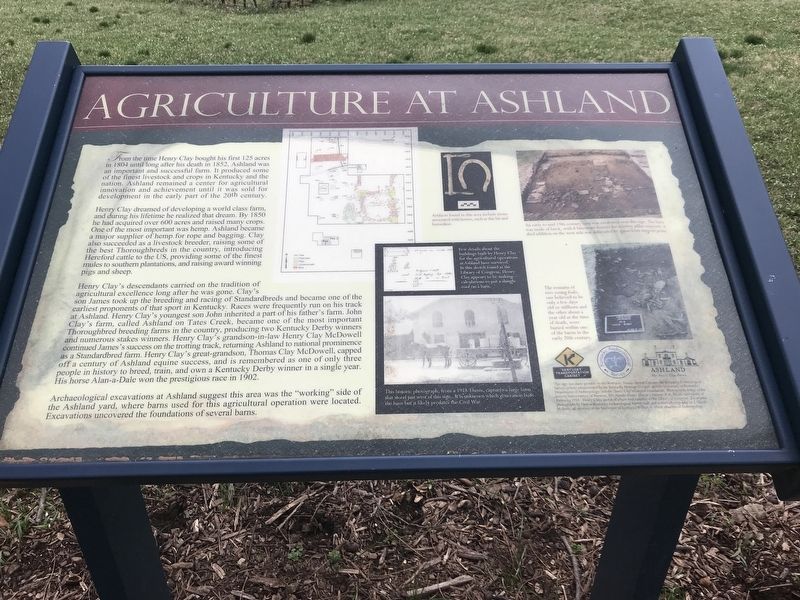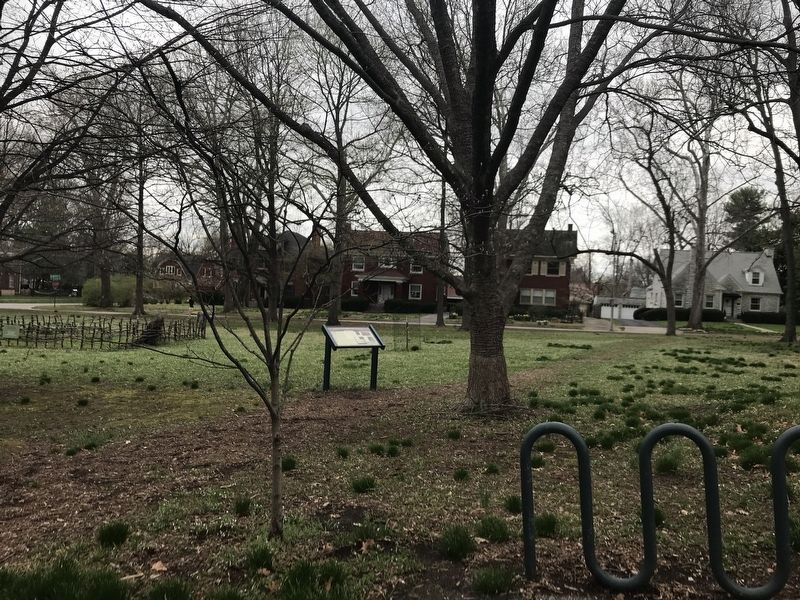Ashland Park in Lexington in Fayette County, Kentucky — The American South (East South Central)
Agriculture at Ashland
Henry Clay dreamed of developing a world class farm, and during his lifetime he realized that dream. By 1850 he had acquired over 600 acres and raised many crops. One of the most important was hemp. Ashland became a major supplier of hemp for rope and bagging. Clay also succeeded as a livestock breeder, raising some of the best Thoroughbreds in the country, introducing Hereford cattle to the US, providing some of the finest mules to southern plantations, and raising award winning pigs and sheep.
Henry Clay's descendants carried on the tradition of agricultural excellence long after he was gone. Clay's son James took up the breeding and racing of Standardbreds and became one of the earliest proponents of that sport in Kentucky. Races were frequently run on his track at Ashland. Henry Clay's youngest son John inherited a part of his father's farm. John Clay's farm, called Ashland on Tates Creek, became one of the most important Thoroughbred breeding farms in the country, producing two Kentucky Derby winners and numerous stakes winners. Henry Clay's grandson-in-law Henry Clay McDowell continued James's success on the trotting track, returning Ashland to national prominence as a Standardbred farm. Henry Clay's great-grandson, Thomas Clay McDowell, capped off a century of Ashland equine success, and is remembered as one of only three people in history to breed, train, and own a Kentucky Derby winner in a single year. His horse Alan-a-Dale won the prestigious race in 1902.
Archaeological excavations at Ashland suggest this area was the “working” side of the Ashland yard, where barns used for this agricultural operation were located. Excavations uncovered the foundations of several barns.
Captions (Clockwise from top right):
• An early to mid 19th century barn was excavated near this sign. The barn was made of brick, with 8 limestone footers for interior pillar supports, A shed addition on the west side was delineated by stains from support posts.
• The remains of two young foals, one believed to be only a few days old or stillborn and the other about a year old at the time of death, were buried within one of the barns in the early 20th century.
• This historic photograph, from a 1918 Thesis, captures a large barn that stood just west of this sign. It is unknown which generation built
the barn but it likely predates the Civil War.
• Few details about the buildings built by Henry Clay for the agricultural operations at Ashland have survived. In this sketch found at the Library of Congress, Henry Clay appears to be making calculations to put a shingle roof on a barn.
• Artifacts found in this area include items associated with horses, such as this bit and horseshoe.
Erected by Kentucky Transportation Cabinet, Kentucky Archaeological Survey and Henry Clay Memorial Foundation.
Topics. This historical marker is listed in these topic lists: Agriculture • Anthropology & Archaeology • Sports.
Location. 38° 1.737′ N, 84° 28.86′ W. Marker is in Lexington, Kentucky, in Fayette County. It is in Ashland Park. Marker is on Sycamore Road north of Fincastle Road, on the right when traveling north. Touch for map. Marker is at or near this postal address: 120 Sycamore Road, Lexington KY 40502, United States of America. Touch for directions.
Other nearby markers. At least 8 other markers are within walking distance of this marker. A&M College at Ashland (a few steps from this marker); "Ashland" (a few steps from this marker); Childhood Home (within shouting distance of this marker); Henry Clay (within shouting distance of this marker); Abraham Lincoln and Henry Clay (within shouting distance of this marker); Madeline M. Breckinridge / Kentucky Suffrage Leader (within shouting distance of this marker); Garden Club of Lexington / Ashland Garden (within shouting distance of this marker); Ashland / Clay & Abraham Lincoln (within shouting distance of this marker). Touch for a list and map of all markers in Lexington.
Credits. This page was last revised on February 12, 2023. It was originally submitted on March 30, 2021, by Duane and Tracy Marsteller of Murfreesboro, Tennessee. This page has been viewed 124 times since then and 15 times this year. Photos: 1, 2. submitted on March 30, 2021, by Duane and Tracy Marsteller of Murfreesboro, Tennessee.

